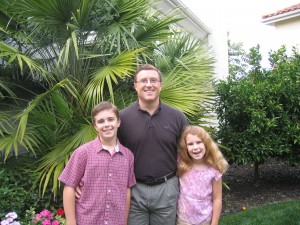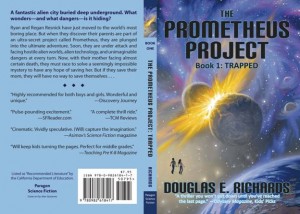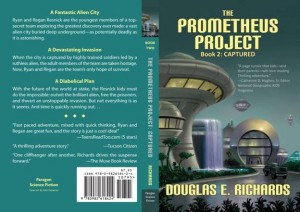By Luisa LaFleur, The Children’s Book Review
Published: April 28, 2009
 Doug E. Richards with his two kids, Ryan and Regan
Doug E. Richards with his two kids, Ryan and Regan
Douglas E. Richards, a biotechnology executive who has degrees in both genetic engineering and business, is the author of the science-fiction mystery series titled The Prometheus Project. We reviewed the first two books in the series earlier this year and had this to say, “The Prometheus Project books are simple, intelligent, fast reads that
even a reluctant reader should have no problems getting into.” You can read the reviews here. We are very happy to share the following interview with you:
Luisa: You’ve recently written two science fiction thrillers for children ages 9-13, The Prometheus Project—TRAPPED and The Prometheus Project—CAPTURED. You also write scientific articles for National Geographic Kids Magazine. Can you explain a little about your writing choices—why the focus on science in particular?
Doug: Actually, I didn’t set out to focus on science at all. I set out to write science fiction thrillers for kids that would keep them glued to the page. This being said, I have a Master’s degree in molecular biology (a.k.a. genetic engineering) so it was important to me that any science included in the books be scrupulously accurate. As a kid, I loved the action, adventure and awesome plots found in science fiction books, as well as the mind-expanding science contained in them. So my goal was to write gripping novels with non-stop action that would propel readers forward, but at the same time include enough science to delight and inspire them—as long as the science served the plot and adventure, and not the other way around. I knew that if the books didn’t have great appeal to kids, no matter how much factual science I put in, no one would ever read them. My thought process was summed up quite nicely by the American Association for the Advancement of Science (AAAS) in their review of CAPTURED: “Like the late Asimov, author Douglas E. Richards knows that compelling, valid scientific speculation makes for equally compelling reading.”
When I finished TRAPPED I had no idea if kids would love it or loathe it—all I could do was hope. Well, I’m very happy to report that the feedback I’ve received to date has been positive beyond my wildest dreams. TRAPPED was “highly recommended” by Kirkus, was called, “perfect for middle grades” by Teaching Pre K-8 Magazine, and a kids panel of reviewers for Odyssey Magazine praised TRAPPED as “a thriller you that you won’t put down until you’ve reached the last page.” The book has received numerous other positive reviews and endorsements from kids and adults alike. TRAPPED has also been added to classroom reading lists and has been used as a read aloud in dozens of classrooms across the country. According to a fifth grade teacher quoted in the San Diego Union-Tribune, “My class loved it. They were totally engaged. It’s a hard book to put down.”
 The fact that kids seem to love both TRAPPED and CAPTURED is unbelievably gratifying to me. And if kids were the only audience to embrace these books, I would have been very satisfied. But a funny thing happened on the way to the forum: these books were embraced by the science community as well. Both books have received glowing reviews/endorsements from the AAAS, the California Science Teachers Association, and a number of other state science teacher associations. TRAPPED now appears on the California Department of Education’s prestigious list of “Recommended Literature for Math & Science” and on Missouri State University’s list of “Best New Books to Engage Students in Math and Science.” ForeWord magazine, in its review of CAPTURED, concluded, “At a time when Americans want more students to become interested in science, the books in this series will likely encourage their interest in a non-threatening way.”
The fact that kids seem to love both TRAPPED and CAPTURED is unbelievably gratifying to me. And if kids were the only audience to embrace these books, I would have been very satisfied. But a funny thing happened on the way to the forum: these books were embraced by the science community as well. Both books have received glowing reviews/endorsements from the AAAS, the California Science Teachers Association, and a number of other state science teacher associations. TRAPPED now appears on the California Department of Education’s prestigious list of “Recommended Literature for Math & Science” and on Missouri State University’s list of “Best New Books to Engage Students in Math and Science.” ForeWord magazine, in its review of CAPTURED, concluded, “At a time when Americans want more students to become interested in science, the books in this series will likely encourage their interest in a non-threatening way.”
 Which brings me to National Geographic KIDS magazine (NG KIDS). An editor at the magazine read TRAPPED, was impressed with my ability to explain complex science to kids, and asked me to try my hand at writing a piece for the magazine. I did so, and the rest is history. I’ve now written thirteen pieces for this award-winning publication and I expect to write many more.
Which brings me to National Geographic KIDS magazine (NG KIDS). An editor at the magazine read TRAPPED, was impressed with my ability to explain complex science to kids, and asked me to try my hand at writing a piece for the magazine. I did so, and the rest is history. I’ve now written thirteen pieces for this award-winning publication and I expect to write many more.
So while I didn’t necessarily set out to focus on science, I couldn’t be happier with how things have turned out. I love writing for NG KIDS, and I love the fact that TRAPPED and CAPTURED have received praise, not only from kids (by far the most important audience) but from parents and educators as well.
Luisa: Can you compare/contrast your experience as a book author and your experience writing for NG KIDS?
Doug: Great question. Writing novels and writing non-fiction for NG KIDS represent quite different challenges. A typical assignment for NG KIDS is something like, “write an 800-word piece on the human brain.” Really? Eight hundred words? Boiling a subject as vast and complicated as the human brain down to this size and finding a way to make it fascinating and understandable to a nine-year-old kid can be immensely challenging. Sometimes I think summarizing the complete works of Shakespeare in a single short paragraph would be easier. In order to craft the most informative and fascinating combination of 800 words from among the billions that have been written on the brain, I first have to immerse myself in the subject. This takes forever. I then have to find an angle on the story—some way to capture kids’ imaginations from the first sentence and hold it throughout. My first draft for a story of this size is usually about 2,000 words. From there I pare it down to about 1,000 words and let the editors decide which of it to use. I agonize over every single word, sometimes spending an hour to get a single sentence just right, wanting the five million people who read every issue to get the best sentence I can deliver.
For my fiction, my greatest challenge is coming up with the plot. I make great demands of my plots. They need to be fast-paced, action-packed, have unexpected twists and turns along the way, and also be logically consistent. Finding the exact right words can be challenging, but figuring out how my unarmed hero is going to cleverly escape from a locked room, surrounded by alarms and heavily armed soldiers, is what really causes a large pile of hair, recently torn from my own head, to accumulate on the floor next to my writing desk.
Luisa: In the Prometheus Project books, are any of your characters based on actual events or real people? How did you come up with the premise for the books?
The books follow the adventures of Ryan and Regan Resnick, the children of two accomplished scientists. These protagonists were named after my own two children, and their physical descriptions match those of my own kids as well. In TRAPPED, the children have just moved to the backwoods of Pennsylvania and are certain they will have the most boring summer of all time. But when they puzzle out secret passwords and overcome laser-beam alarm systems, barbed-wire fences and security guards, they learn that their parents are part of the Prometheus Project — a top-secret team investigating an abandoned alien city. When their mother’s life is in jeopardy, they must face unimaginable dangers and fight against impossible odds to save her.
In the second book, CAPTURED, the kids have been made members of the Prometheus Project because of the valuable contributions they made to the team during their first adventure. When an alien city is captured by a team of mercenaries and their ruthless leader, the adult members of the Prometheus team are taken hostage, and the children become the team’s only hope. With the future of the world at stake, Ryan and Regan must do the impossible: outwit the brilliant alien and his well-trained force, free the prisoners, and thwart an unstoppable invasion.
I picked the setting of a vast alien city, filled with advanced science and technology, because I knew it would be a fertile springboard from which to launch numerous science fiction plots and to explore any number of scientific topics. My hope is to write many more books in the series over the coming years.
Luisa: What’s the biggest obstacle you face when writing?
Doug: As I mentioned earlier, coming up with a complex plot is the most challenging aspect for me.
Luisa: Conversely, what brings you the most joy?
Doug: I love when I’ve solved the plot aspects of a scene and I can focus solely on the writing. It’s times like these when the passage of hours seems like minutes because I’m so immersed in the world I’m creating. Typically, the final quarter of a book is the easiest to write (before the dozens of revisions, of course) because it almost writes itself. I think of a book as a 5,000-piece jigsaw puzzle. When you start it can be very difficult, because you have near infinite degrees of freedom, and finding the pieces that work well together takes considerable effort. But the more you build out the puzzle, the easier and easier adding additional pieces becomes, and the picture of what you have built, and what you are building toward, becomes clearer and clearer. At the end, of course, when there are only a few pieces left, placing them is a breeze.
Luisa: Have any of your personal experiences influenced your work? What were you like as a kid?
Doug: I loved science fiction and talking my way into and out of trouble (the harmless kind—not the malicious kind). I used to love tricking or outsmarting adults, and my protagonists use these same skills to extricate themselves from life-threatening situations in my books.
Luisa: If you could have a chat with any author, who would it be, and what would you ask?
Doug: Isaac Asimov. He was a professor of biochemistry and one of my all time favorite authors as a kid. In addition to best-selling science fiction he wrote hundreds of books on an unbelievably eclectic list of topics, including science, the bible, mythology, history, and many others. The recent movie, “I Robot,” with Will Smith, was based on his work.
I would love to chat with Asimov about writing, quantum physics, his view of the universe—in fact, if I had to be trapped for a year with one person (other than my wife) it would be him. I think conversations with Asimov would be endlessly fascinating and thought provoking.
Luisa: You’re a multi-talented writer. But aside from this, what is the one talent you wish you had?
Doug: I really wish I could teleport. I love being at a destination, but I often dislike the process of getting there. Sitting in bumper-to-bumper traffic drives me crazy. When I was a biotechnology executive I often traveled coast-to-coast (and to Europe and Japan) and I always felt horrible after a long flight. If I could teleport I wouldn’t have to deal with any of that — nor ever worry about finding a parking spot again. Now that would be a talent worth having.
